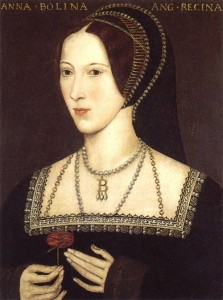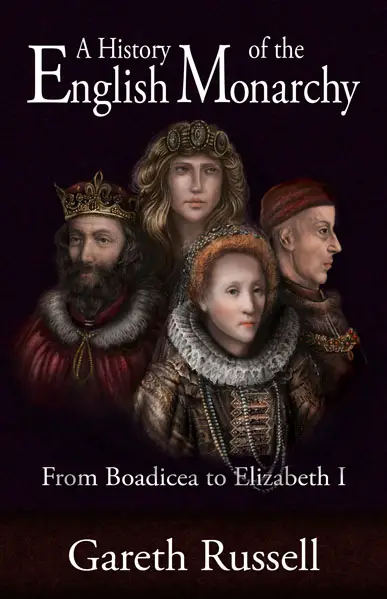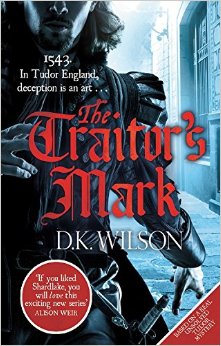
Anne Boleyn, one of the children of Thomas and Elizabeth Boleyn
There is a consensus among modern historians that, of the three of five surviving children who reached adulthood, Mary was the eldest, followed by Anne, with George the youngest.1 An alternative theory, but one which has garnered much less support among scholars, sees George as the eldest surviving child, followed by Anne, with Mary the youngest.2 Much of the uncertainty about the birth order of the Boleyn siblings is explained by the silences regarding their respective dates of birth. This article seeks to offer a credible theory for the birth order of the Boleyn children.
The date of Sir Thomas’s marriage to Elizabeth, as stated, is not known with certainty, but historians have concluded that it had taken place by 1500.3 The couple’s jointure was settled on them in November 1501, which indicates a relatively recent marriage. In 1997, Anthony Hoskins suggested that Thomas married Elizabeth sometime in 1500.4 The seventeenth-century antiquarian John Weever, author of Ancient Funerall Monuments, reported that Anne Boleyn, born in 1507, was the elder daughter of Thomas and Elizabeth. He confirmed that Henry VIII had fallen in love with Anne when he was aged thirty-eight and she was twenty-two.5 It has been suggested that Weever echoed ‘the prevailing Stuart view’ regarding Anne’s birth date, and it is possible that he had been influenced by William Camden, who stated in his Annales; or the history of the most renowned and victorious princesse Elizabeth, late queen of England that Queen Elizabeth’s mother had been born in 1507.6 Warnicke regards Camden’s statement as accurate, believing that, had Anne been thirty-two years of age when she gave birth to Elizabeth in 1533, contemporary historians would have commented on it.7
Certainly contemporary evidence is not particularly supportive of the 1501 birth date advocated by the majority of modern historians. Jane Dormer, duchess of Feria and close confidant of Anne’s stepdaughter Mary Tudor, reported to Henry Clifford, her biographer, that Anne had been ‘not twenty-nine years of age’ when she was executed in May 1536, which implies that she was nearing her next birthday and so was born in the summer of 1507.8 Although Clifford had consulted Camden’s Annales, as Warnicke explains there is no good reason to doubt either man’s testimony about the age of Queen Elizabeth’s mother.9 By contrast, the hostile Nicholas Sander, who claimed that Anne was the daughter of Henry VIII and portrayed her as witch-like, asserted that she was the younger daughter and claimed that she was born around 1500.10
In 1513, Anne departed for the continent. She served in the household of Margaret of Austria, before journeying to France to serve Mary Tudor, sister of the English king, following her marriage to Louis XII of France. Anne’s appointment has provided concrete evidence of the 1501 birth date for most historians. Yet her exact position abroad is uncertain. It has been argued that she may have actually, to begin with, dwelled in the nursery alongside the children raised by Margaret: Charles, later Holy Roman Emperor; Eleanor, later queen of Portugal and France; Isabella, later queen of Denmark; and Mary, later queen of Hungary.11 Contemporaries were united in their belief that Anne had been very young when abroad. George Cavendish, gentleman usher of Cardinal Wolsey, described her thus: ‘This gentlewoman, Mistress Anne Boleyn, being very young was sent into the realm of France’. William Forrest later referred to Anne as ‘a fresh young damsel’ when the king first fell in love with her, while Cardinal Reginald Pole alluded to her as a ‘girl’.12 As is well known, the Archduchess Margaret herself described Anne as ‘so bright and so pleasant for her young age’.13
When Anne returned to England in late 1521 or early 1522, she anticipated her wedding to James Butler in an initiative sponsored by the king and cardinal to resolve tensions between the Boleyns and the Butlers, who competed over the earldom of Ormond. Because of complex Anglo-Irish politics, the marriage did not occur. It was later recorded that Anne entered into a secret engagement with Henry Percy, heir to the earldom of Northumberland, sometime in 1523, before the cardinal discovered it and upbraided Percy. Anne herself was dismissed from court at this time, and perhaps only returned in 1525-6. Aside from her liaison with Percy, the details of which are surrounded in mystery, there is no other evidence that her father or uncle sought a marriage for her between 1522 (when the Butler marriage was broken off) and 1526, when the king fell in love with her. Surely, a logical question would be, why there was no concerted effort to achieve Anne’s marriage during these years, if she was (as the 1501 birth date would have it) between 21 and 25 years of age? Gentlewomen and the nobility married young during this period. Anne’s mother was married between the age of 18 and 21, while Mary Boleyn was probably no more than 21 at the time of her marriage. Anne’s sister-in-law, Jane Parker, married George in 1524 when she was perhaps only 19 years of age. Katherine Parr’s first marriage was negotiated by her mother before Katherine had attained the age of twelve, although her marriage actually took place when Katherine was seventeen. The average age of marriage for Tudor noblewomen was 20.14 A possible answer to this dilemma requires careful consideration of the 1507 birth date: if she had returned from France aged only fourteen years old in order to marry Butler, when the marriage plans fell through there would have been no rush to marry Anne off to someone else, given her youth. Her father could reasonably have believed that his daughter could remain in her unmarried state for another four or five years. When the king began his courtship of her in 1526, she would have been aged only nineteen. The absence of initiatives among Anne’s male relations between 1522 and 1526 to secure her marriage can be explained by the fact that her youth allowed for the matter to rest until she was of a more appropriate age. Moreover, although details of her liaison with Henry Percy are mostly given only by George Cavendish, biographer of Cardinal Wolsey, the hastiness and defiance involved in defying social and political custom are perhaps more indicative of an impressionable sixteen-year-old than they are of a mature twenty-three year-old woman well acquainted with court protocol.
As has been seen, there is an abundance of contemporary testimony about Anne Boleyn’s youth chronicled during the early and mid-1520s. Although Thomas Boleyn recalled in a letter written to Cromwell that his wife had brought him every year a child, he could also have been including any miscarriages and stillbirths that she had experienced. In the absence of convincing evidence that Anne was born as early as 1501, there is no good reason to doubt the 1507 birth date, for contemporaries were united in their belief that Anne was both tender in her years in France and a young gentlewoman when Henry VIII selected her to be his consort. Although the Imperial ambassador hostilely referred to her as ‘a thin old woman’ in the spring of 1536, this comment is not necessarily indicative of Anne’s approaching middle age: she had recently experienced a traumatic miscarriage that had left her ‘in much peril of her life’, and given that the event occurred only months before her execution, it is more than likely that she was experiencing unusual stress, emotional turmoil and distress at the time when the ambassador recorded his view of her appearance. While it might seem bizarre that a six-year old girl departed for the continent to serve in a royal household, this occurrence is explicable given that we do not know exactly what Anne’s role was. She was later described as a ‘demoiselle’ and maid of honour to the French queen, but it is reasonable that she served the queen only later, say in 1519-20, and spent her earlier years residing among those of a similar age.
If Anne was born, then, in the summer of 1507, it follows that her sister Mary must have been older than her. Warnicke conjectured that Mary was the younger sister, believing that she did not accompany her sister to France and married William Carey when she was probably less than twelve years of age.15 While it seems likely that Mary did not reside in France, it is unlikely that she was born as late as 1508. Her offspring certainly believed her to be the older sister, and historians have mainly affirmed that she was the elder sister given that she married before her sister Anne. Whether Mary was older or younger than Anne is an issue as mysterious as that of Anne Boleyn’s birthdate.16 On a balance of probabilities it seems likely that she was the elder daughter and was born relatively soon after her parents married, perhaps in 1501, given that her marriage occurred in early 1520 when she might have been eighteen or nineteen years of age. Her brother George was almost certainly born around 1504.17
The evidence uncovered in this article, when read in light of Tudor marriage customs and attitudes to youth, challenge the prevailing view among historians that Mary was the oldest surviving Boleyn child, followed by Anne and then George. While it seems likely that Mary was indeed the oldest surviving sibling, this article has indicated that George was probably older than his sister Anne, who would therefore have been the youngest surviving Boleyn child. Mary was probably born around 1501, followed by George in 1504 and Anne in 1507. Their brothers Thomas and Henry would have been born in the intervening years, while Elizabeth Boleyn might also, like so many women of the period, have suffered miscarriages and stillbirths during this time. Although I was a firm proponent of the 1501 birth date, when I analysed the considerable evidence concerning Anne Boleyn’s age, I was eventually persuaded that it is much more likely that she was born in 1507. A sound understanding of early modern cultural, political and social customs helps to clarify much of the uncertainty regarding the birth dates of the Boleyn siblings.
Conor Byrne, author of Katherine Howard: A New History is a British undergraduate studying History at the University of Exeter. Conor has been fascinated by the Tudors, medieval and early modern history from the age of eleven, particularly the lives of European kings and queens. His research into Katherine Howard, fifth consort of Henry VIII of England, began in 2011-12, and his first extended essay on her, related to the subject of her downfall in 1541-2, was written for an Oxford University competition. Since then Conor has embarked on a full-length study of Queen Katharine's career, encompassing original research and drawing on extended reading into sixteenth-century gender, sexuality and honour. Some of the conclusions reached are controversial and likely to spark considerable debate, but Conor hopes for a thorough reassessment of Katherine Howard's life.
Conor runs a historical blog which explores a diverse range of historical topics and issues. He is also interested in modern European, Russian, and African history, and, more broadly, researches the lives of medieval queens, including current research into the defamed ‘she-wolf’ bride of Edward II, Isabella of France.
Notes and sources
- See Eric Ives, The Life and Death of Anne Boleyn (Oxford, 2004); Alison Weir, The Six Wives of Henry VIII (London, 1991); Antonia Fraser, The Six Wives of Henry VIII (London, 1992); David Starkey, Six Wives: The Queens of Henry VIII (London, 2004); Joanna Denny, Anne Boleyn; A New Life of England’s Tragic Queen (London, 2004); Amy Licence, The Six Wives and Many Mistresses of Henry VIII (Stroud, 2014).
- Retha M. Warnicke, The Rise and Fall of Anne Boleyn: Family Politics at the Court of Henry VIII (Cambridge, 1989); Retha M. Warnicke, ‘Anne Boleyn’s Childhood and Adolescence’, The Historical Journal 28 (1985), 939-52.
- Jonathan Hughes, ‘Thomas Boleyn, earl of Wiltshire and earl of Ormond (1476/7-1539), courtier and nobleman’, Oxford Dictionary of National Biography (2004); accessed at http://oxforddnb.com/view/article/2795?docPos=1.
- Anthony Hoskins, ‘Mary Boleyn’s Carey Children – Offspring of King Henry VIII?’ Genealogists’ Magazine 25 (1997); accessed online at http://www.genealogymagazine.com/boleyn.html.
- John Weever, Ancient Funerall Monuments (London, 1631), pp. 514, 799.
- Warnicke, ‘Anne Boleyn’s Childhood’, 940.
- Ibid.
- Gareth Russell, ‘The Age of Anne Boleyn’ (2010); accessed at http://garethrussellcidevant.blogspot.co.uk/2010/04/age-of-anne-boleyn.html.
- Warnicke, ‘Anne Boleyn’s Childhood’, 942.
- Retha M. Warnicke, Wicked Women of Tudor England: Queens, Aristocrats, Commoners (New York, 2012), p. 31.
- Warnicke, ‘Anne Boleyn’s Childhood’, 944; see also Warnicke, Rise and Fall.
- Warnicke, Wicked Women, p. 27.
- Russell, ‘Age of Anne Boleyn’.
- Warnicke, Rise and Fall.
- Ibid, chapters one and two.
- In my article ‘Mary Boleyn: A Reassessment’, I conjectured that Anne Boleyn was the elder sister and was born around 1501, with Mary following a year or two later. I accepted Warnicke’s evidence that Mary’s family believed her to be younger than Anne. Since writing that article, I have been persuaded that Anne probably was born in 1507. If she was born as late as 1507, it becomes difficult to accept that Mary was born in 1508 and was younger than Anne. Mary would have been only eleven years old at the time of her marriage, which seems inexplicable, given that the Boleyns were not royalty or even premier nobility. If the Boleyns married no later than 1501, it seems plausible that Mary was born sometime earlier than 1508, given that she had four surviving siblings.
- Joseph S. Block, ‘George Boleyn, Viscount Rochford (c.1504-1536), courtier and diplomat’, Oxford Dictionary of National Biography (2004); accessed online at http://oxforddnb.com/view/article/2793?docPos=1.



I’ve been debating this with Gareth Russell for a few years and we decided to agree to disagree! While I can see that their are valid arguments for a 1507 birthdate for Anne Boleyn, the main stumbling block for me is the fact that Anne was recalled from Mechelen to serve Mary Tudor and after that “was in the service of the French queen”. Nicholas Throckmorton also wrote of how Renée of France, Duchess of Ferrara and sister of Queen Claude, told him that she knew Anne from when Anne was “one of the maids-of-honour of the Duchess’s sister, Queen Claude.” Anne was described as “in the service” and as being a maid-of-honour to Claude, rather than being brought up in the nursery there or being tutored. If she was born in 1507 then she would only have been 7 when she served Mary Tudor and 7-14 when she served Queen Claude.
As Hugh Paget points out in his article “The Youth of Anne Boleyn”, Emperor Maximilian, in a letter to his daughter Margaret of Austria, wrote of Don Diego de Guevarre’s niece now being of an appropriate age to join her household as “demoiselle d’honneur” with her now being 13/14, so I just can’t see Anne joining Margaret’s household at 6, Mary Tudor’s at 7 and Queen Claude’s at 7/8. It just doesn’t make sense to me.
Couple of things. I always caution using the LIfe of Jane Dormer book as while the story was allegedly told to the author in the 1620’s it wasn’t published until much later.
That said there is another example for the 1507 birthdate that Mr. Bryne did not mention. Anne Brandon, the eldest child of Charles Brandon. Anne Brandon was the daughter of Charles Brandon and Anne Browne. Charles abandoned Anne Browne to marry Margaret Neville. Anne Browne was pregnant with Anne Brandon and gave birth to her in 1507-1508. Following the declaration that the marriage to Margaret Neville was invalid Charles Brandon married Anne Browne in 1509. Charles Brandon obtained a position at the court of Margaret of Austria for his daughter in 1514. She was at most 7 years old. Given Charles Brandon’s rather colorful marital history, he petitioned the Pope to declare his marriage with Henry VIII’s sister Mary valid and their children legitimate. In the same Papal document Anne Brandon was also declared legitimate.
Great article and insights! This ongoing discussion about Anne’s birthdate continues to intrigue me, so your detailed points are certainly interesting to contemplate!
I most definitely believe Anne was born in around 1507. It totally explains Henry’s actions when she came back to the English court. She was too young for Henry to seriously pursue but he kept her in the wings until she was old enough. It’s absurd to think he wasn’t aware of her!
I just had another thought. I have read on numerous occasions that Anne spoke French like a native. As I understand, if a child is quite young when introduced to a foreign language, there is less chance of an accent. For Anne to start learning French at the age of 6 or 7 and be immersed in the language for several years would ensure she spoke like a native. At the end of the day, I just struggle with the idea that Henry would fall madly in love with an “older” woman. I just don’t believe it. There would be too much risk in terms of the woman not being able to bear a healthy child. I’m 100% a believer in 1507 for Anne’s birth.